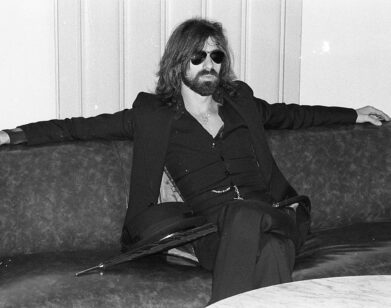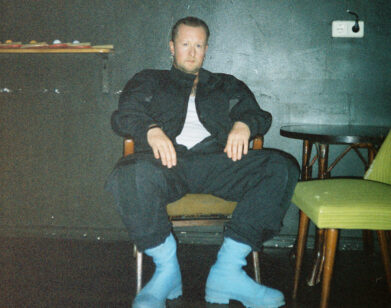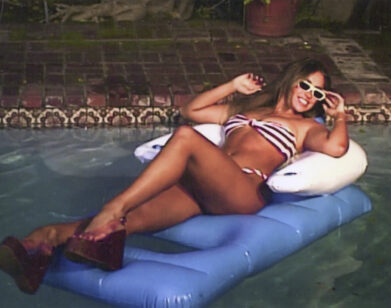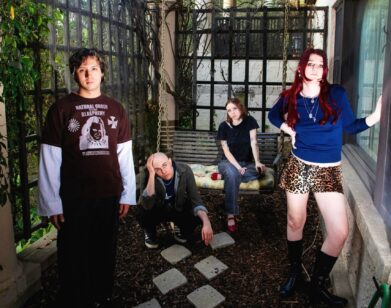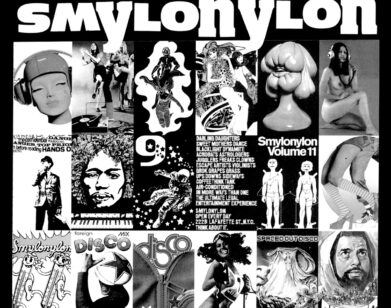Ten Years of TV on the Radio
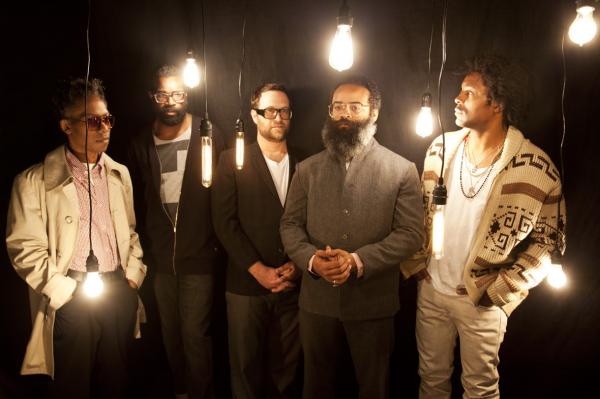
TV ON THE RADIO, WITH SLIGHTLY FEWER THAN NINE TYPES OF LIGHT.
One would think, after five albums and dozens of collaborations and politically-minded compilations, Brooklyn’s TV on the Radio would interpret their trajectory like the rest of the music world does—with utmost seriousness. Nearing their tenth anniversary and known for achingly poetic lyrics and gallery-worthy music videos, the quintet ought to be contemplative, reflecting on the decade from the stoic perspective of artistes.
Yet, this is not the case: the guys of TV on the Radio are surprisingly, and delightfully, fun. It’s not that they don’t treat their music—the band exemplifies modern “art rock”—with appropriate gravitas; but one would think a band that teams up with legends like the Davids Bowie and Byrne or Peter Murphy would not be so quick to laugh, so humble about their own careers. At one point during our talk, Kyp Malone interrupted to do an ecstatic dance. Keyboardist/guitarist Jaleel Bunton described himself as the member who “hits and pokes things.” Even frontman Tunde Adebimpe oscillated from comedian to band documentarian, poking fun at his bandmates.
So once again, TV on the Radio bucks expectations and disregards stereotypes; not surprising, they’ve been doing so since their inception. Whether the topic is race, politics, whom an indie band should work with, or how charming a group of esteemed musicians should be, the guys are pros at boundary-blurring, and their new album Nine Types Of Light-the most rock-inspired offering to date-continues to prove that TV on the Radio will never settle for being just a Brooklyn band.
LEILA BRILLSON: You guys are very much from Brooklyn. Can you talk about kind of what the last ten years have been like in New York? What are the challenges or great things you’ve witnessed?
JALEEL BUNTON: I moved to Brooklyn in 1994. Our decade in Brooklyn was playing in the band, so we actually weren’t in the borough as much. We would go back to after being on tour for so long—it didn’t change in increments, it was a bulk change. We may be more attached to the ’90s Brooklyn than millennial Brooklyn.
TUNDE ADEBIMPE: Brooklyn is so different from when we were first starting out. I got to meet so many creative people, because it was extremely inexpensive to live there in the late ’90s and the early 2000s. You’d work a day job and make art. Now the loft where Dave and I started making music is a condominium.
BUNTON: A luxury condominium.
ADEBIMPE: Luxury condominium with a wine shop downstairs. I went in to see what the apartments were like, and the corner apartment now is the price of the entire floor. This wasn’t where ten people were going to find a place to hole up and make art.
BRILLSON: But are there still pockets of artistic creativity?
BUNTON: Yeah, there are definitely pockets.
ADEBIMPE: I’m talking about really the area we were in, which is considered central Williamsburg, which is like a weird “back to the future” where everything went wrong. But yeah there are tons of pockets where people are thriving and making good stuff.
BUNTON: In New York, things are always changing. West Village, Soho, Harlem—that’s what New York is… that’s what it does.
BRILLSON: What about the younger musicians for whom you’ve paved the way? Artists who were like, “Oh, TV on the Radio did it; Brooklyn must be this central location of creativity. We ought to move there.” What challenges do they need to overcome?
ADEBIMPE: When we started a band, it was just when blogs and online venues started to crop up, so there wasn’t the pressure of… well, let’s just say we did a lot of practicing in public. [laughs] For a long time. I’ve had conversations with younger musicians where their concerns are so different than what my concerns were. They’re so petrified by someone like Pitchfork giving them a negative review, because it’s real currency to them. I’m glad we came up at a time where blog criticism was real only if you wanted it to be. In some ways, that might make you take yourself more seriously, or it could be a really annoying.
BUNTON: But if you can get enough hits on the Internet, then you’ll be able to find the audience. Now, in every city, you can find one hundred people who like your band, meaning there are thousands and thousands of people hearing your music that weren’t before.
BRILLSON: As a band, you’ve certainly gone through stages: the atmospheric, the poetic, the rock-infused, and so on. Is there anything you would have done differently? Is there anything you are glad you did?
ADEBIMPE: I’m glad we did everything the way we did, creatively at least. Of course, we could have been better businesspeople. [laughs]
BUNTON: When Young Liars came out, I hadn’t even played with the band yet, but I was so proud. So I underestimated my intuition that this could be anything but marginal. In the beginning, we just did whatever, because we were never used to getting anything. Maybe we could have been a little cockier or more stubborn.
BRILLSON: From the wildly rock-and-roll to the utterly romantic, and by opening and touring with many other musicians who may not share your fan base, you’ve really embraced the fringe. What is it like to be an anomaly—the rock-and-rollers who don’t play rock-and-roll? (Or vice versa?) Do we hear that in Nine Types of Light?
ADEBIMPE: As far as collaboration or influences, TVOTR has never been limited. That approach seems much more forced to me than any genuine creative growth. We have been lucky enough just to know people, and though we aren’t doing the same thing, there is a commonality of intention of wanting to do something different.
BRILLSON: Thematically.
ADEBIMPE: Yeah, yeah. There is always enough room for absolutely everything. To decide I’m only into Fugazi, and because I’m into Fugazi I can’t ever listen to a jazz singer/musician, just seems really strange to me. Between the five of us we have so many influences, so every record is an accurate shot of our overlapping inspirations.
BRILLSON: Tell me about your new record. What are the “overlapping inspirations”?
ADEBIMPE: We were in Los Angeles. I like a lot of LA, but I didn’t like where we were staying. But that made the experience like this writer’s colony; you were so petrified of having any sort of contact with anything outside of your room, you go into some type of deep self-reflection to keep yourself afloat. We were going for coffee in the morning, and there were two reality shows being shot on either end of the café.
BRILLSON: Is that reflected in this album?
ADEBIMPE: In pieces. It’s definitely not a negative record. It’s a really warm record. I felt like we kept things simpler than what we usually do.
BUNTON: A lot of what happens is intuitive—not that there wasn’t any planning—but if you are too aware of everything you are digesting and regurgitating, then it becomes a little more contrived. You have to just let things come out as best they can, with as little obsessing as possible.
BRILLSON: Can you describe your favorite moment in the record?
ADEBIMPE: It was really strange to see how things came together. Dave moved to LA, so it was the first time in a long time that he wasn’t just down the block. It was weird having a demo that was kicking around for two months. We brought it to California. The funny thing about Dave’s studio is that it’s a room in his house that’s so small that only three people can be there at a time comfortably—
BUNTON: And one has to be the engineer.
ADEBIMPE: Exactly. And the other two are just sitting outside the door listening to what’s happening. It was cool to hear the songs come together the way they did, even though we weren’t around each other as much. When they did come together, everything just started sounding really great very quickly.
BUNTON: When we were mixing the record, we took some time off in between recording and mixing, so we had distance from the songs. At the end of the song “Forgotten,” after it was nice and cleaned up—I felt really proud. You get insecure, especially when you take time off in between, where you think, “What did I just do? What did I just make?” I hadn’t heard it in a long time, and hearing it made me feel like I’m doing the right thing for the right reason. It felt like Young Liars.
BRILLSON: Since you guys are going on tour, what is personally one of your favorite songs to play?
ADEBIMPE: I like playing “Young Liars” a lot.
BRILLSON: An oldie.
ADEBIMPE: Yeah, an oldie. There is a new song on the record called “Repetition” that’s really fun to play.
BUNTON: We leave some space in the song to expand and contract, which is important when you’re playing shows everyday. You don’t want the songs to become redundant. We wrote a song that was designed to be malleable on stage.
BRILLSON: You came from a filmmaking background, right?
ADEBIMPE: Yeah I’m still in that background, I still want to make movies a lot. For this record, there is going to be a ten-video-long movie attached to it, so we got ten different directors to do a video for every song. I shot a short film that is going to tie them all together.
BRILLSON: Who’ll be involved?
ADEBIMPE: Barney Clay, Dugan O’Neal and Michael Please, amongst others. They’re like short films. Some are more straight-up videos and others are more conceptual. It’s going to be really fun to watch. I just wanted to let people know that the new album has some really incredible elements.
NINE TYPES OF LIGHT COMES OUT TUESDAY, APRIL 12. YOU CAN STREAM THE ALBUM HERE.

